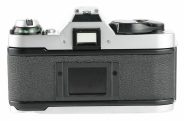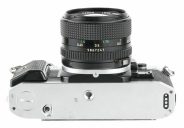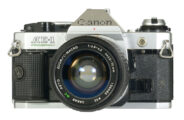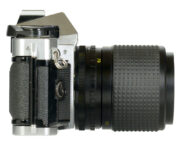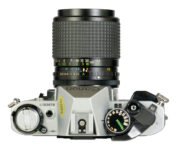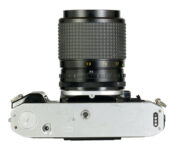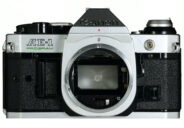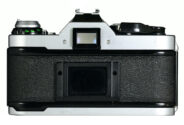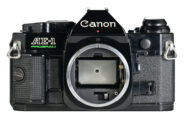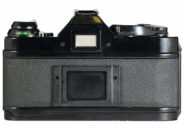Canon AE-1 PROGRAM
35mm MF film SLR camera • Discontinued
- Announced:
- · April 1981
- Production status:
- ● Discontinued
- Country of design:
- · Japan
- System:
- · Canon FD (1971)
Specification
| Format: | |
| 35mm full frame | |
Film type: | 135 cartridge-loaded film |
| Canon FD [42mm] | |
| Shutter: | |
Type: | Focal-plane |
Model: | Electronically controlled |
Speeds: | 2 - 1/1000 + B |
| Exposure: | |
Exposure metering: | Through-the-lens (TTL), open-aperture |
Exposure modes: | Programmed Auto |
| Shutter-priority Auto | |
| Manual | |
| Physical characteristics: | |
Weight: | 565g |
Dimensions: | 141x88x47.5mm |
Manufacturer description #1
It was five years after the AE-1 became a worldwide hit. Many users wanted the program AE mode that was featured in the A-1. This mode set both the shutter speed and aperture automatically. The user just had to press the shutter button.
The AE-1 Program camera was developed in response to the demand for program AE and to succeed the original AE-1. The camera now had both shutter speed-priority AE and program AE modes. It also sported a palm grip like the A-1. The camera was also compatible with the A-1’s Motor Drive MA. The viewfinder featured LEDs. It was quite an advanced camera.
To make Motor Drive MA compatible with the AE-1 Program camera, it had three electrical contacts instead of only two which the original version had. Also, Power Winder A was converted into Power Winder A2 for higher performance.
Manufacturer description #2
The Canon AE-1 PROGRAM is a superb example of contemporary camera design with the versatility of multi-mode operation. The AE-1 PROGRAM's three automatic exposure modes are programmed AE, shutter-speed priority AE, and fully automatic flash exposure.
Besides the choice between the programmed automation and shutter-speed priority mode, the camera offers a completely manual mode, ie. manual setting of both shutter speed and aperture, with LED readout of recommended aperture for correct exposure.
Programmed AE
One particularly distinctive feature of the AE-1 PROGRAM even became part of the camera's name: the Programmed AE mode. This programmed AE mode makes even 35mm SLR photography "focus and shoot" easy by leaving both the shutter speed and aperture selections to the camera's computer brain.
Just set the shutter speed selector dial to "PROGRAM", make sure the lens aperture ring is set on "A", and then just focus and shoot! Even a person with no knowledge of photography can get perfect pictures from the very first roll.
In the programmed mode, depressing the shutter release button halfway illuminates a bright green ↯ in the view- finder, along with the aperture in use. As the light level varies, both speed and aperture change. The "P" will flash under low light conditions to warn that speeds below 1/30 sec. are being selected.
Shutter-Speed Priority AE
In the shutter-speed priority AE mode, you select a shutter speed and the camera will set the aperture. The appropriate f/stop is displayed in the viewfinder, providing a reference for the depth of field. The apertures automatically change as light levels increase or decrease. Should the lighting be outside the meter coupling range, the fl stop will blink, warning you to select a different speed. The beginner should find shutter-speed priority especially useful to prevent blur caused by camera shake and experienced photographer should find this mode useful to purposely cause blur for creative effect.
Manual
Even with a camera as fully automated as the AE-1 PROGRAM, both shutter speed and aperture can be at your command. It is possible to select any number of a variety of specific combinations of shutter speed and lens aperture to cope with special lighting situations and to add creativity to your work. The procedure is simple. You set shutter speed you want on the shutter speed selector dial and remove the lens aperture ring from the "A" automatic position.
Upon partially depressing the shutter button, an "M" will show in the viewfinder, telling you the camera is on manual. The aperture in the viewfinder indicates correct exposure as a convenient reference but you can set any manual aperture you want.
Brighter Viewfinder and New Split Screen
Looking through the AE-1 PROGRAM's viewfinder, you will notice something different:you will see your subject brighter and clearer than ever. This is due to two factors: First, exposure information is not shown until you want it, when you depress the shutter release button partially.
Until then you can totally concentrate on picture composition. Exposure information appears in clearly-viewed LEDs whose brightness varies according to the subject brightness so they are always easy to read. And as to the aperture, diode lights up only for the aperture selected by the camera's metering system.
Equally important is the AE-1 PROGRAM's New Split rangefinder and laser-matte screen. A world's first, the New Split is composed of crossed prisms with two angles forming a grating. With the single-angled conventional split-image, the central rangefinder did not always work too well with lenses having a maximum speed of f/5.6. One or the other rangefinder semi-circles darkened and you were compelled to use the outer focusing areas.
But with the New Split focusing screen, the image remains bright even at the small opening of f/5.6. All focusing screens for the AE-1 PROGRAM have laser matte and the new surface eliminates problems of moire too. For all general photographic purpose, the standard screen with New Split rangefinder, microprism collar and full focusing screen should be sufficient. Seven other types of focusing screen are available for the AE-1 PROGRAM and all focusing screens are interchangeable by the user.
Automatic Speedlites
Designed with the AE-1 PROGRAM is another addition to the Canon Speedlite series: the Speedlite 188A for flash automation similar to the arrangement for the Canon AE-1 in that a special flash unit, when fitted to the hot shoe of the AE-1 PROGRAM, will set the proper shutter speed (1/60 sec.) on the camera and one of the auto-flash apertures on the lens for automatic flash exposure (while the lens aperture ring is kept at the "A" automatic position). The arrangement is identical only this far. To indicate completion of charge, a green "blitz" mark ↯ appears in the viewfinder. And to indicate that there was sufficient illumination for the shooting distance, the green ↯ flashes on and off for two seconds (again right in the viewfinder) after firing. The latter feature of auto flash checklight (confidence light) right in the viewfinder is exclusive to the 188A/AE-1 PROGRAM combination.
Automatic Winders
To keep you shooting paced with the action, the AE-1 PROGRAM offers a choice of three motorized film advance systems: the new Power Winder A2, the Motor Drive MA with the choice of two power packs, and the Power Winder A. Lightweight and compact, each quickly attaches to the camera's body to form a well-balanced, versatile combination.
The Motor Drive MA has three speed settings, including single frame, and can shoot at 4 frames per second. The Battery Pack MA and the rechargeable Ni-Cd Pack MA are the two power packs for the Motor Drive MA, motor unit. The Power Winders A and A2 shoot at approximately 2 fps. The Power Winder A's Single frame and continuous shooting modes are both controlled with the camera's shutter release, while the A2 has a handy switch for selecting either continuous or single frame shooting.
For the AE-1 PROGRAM/motor drive or power winder (A2) combination, remote shooting is possible using Remote Switch accessories with connecting cords or wireless shooting without cords using the Wireless Controller LC-1.
Manufacturer description #3
Type: 35mm single-lens reflex (SLR) camera with electronically-controlled automatic exposure (AE) and focal-plane shutter.
Exposure Modes: Programmed AE, shutter-speed priority AE, AE flash photography with specified Canon electronic flash units, and manual override.
Format: 24 x 36mm.
Usable Lenses: Canon FD (for full-aperture metering) and Canon FL and non-FD (for stopped-down metering) series lenses.
Standard Lenses: FD 50mm f/1.2, FD 50mm f/1.4, FD 50mm f/1.8
Lens Mount: Canon breech-lock mount
Viewfinder Information: Fixed eye-level pentaprism. Gives 94% vertical and 94% horizontal coverage of the actual picture area with 0.83x magnification at infinity with a standard lens. Information is displayed in form of LED digital display to the right of viewing area. Includes "P" mark (programmed AE and camera shake warning indicator), "M" mark (manual aperture control indicator), aperture display (f/1 - f/32, in full f/stops), flashing warning for overexposure and underexposure, stopped-down metering index, ↯ mark (flash charge-completion display with specified Canon flash units and auto-exposure flash confirmation signal with Speedlite 188A and 166A).
Dioptric Adjustment: Built-in eyepiece is adjusted to standard -1 diopter.
Focusing Screen: Standard split-image/microprism rangefinder. Seven other types of interchangeable screens are available optionally.
AE Mechanism: Electronically-controlled, programmed AE and shutter-speed priority AE metering system using one IC and three LSI's with I2L.
Light Metering System: Through-the-lens (TTL), Center-Weighted Averaging by silicon photocell (SPC).
Meter Coupling Range: EV 1 (1 sec. at f/1.4) to EV 18 (1/1000 sec. at f/16) with ISO/ASA 100 film and f/1.4 speed lens.
Exposure Memory: EV locked in when shutter button is pressed halfway and the AE lock switch is pressed once. Exposure is memorized as long as shutter button is pressed halfway.
Exposure Preview: By pressing shutter button or exposure preview switch.
Shutter: Cloth, focal-plane, 4-spindle, electronically-controlled. With shock and noise absorbers.
Mirror: Instant-return, with shock-absorber.
Film Speed Scale: ISO/ASA 12-3200.
Shutter Speed Selector Dial: 2 sec. - 1/1000 sec., plus "PROGRAM" and "B." With guard.
Shutter Release Button: Two-step, electromagnetic shutter release button. Also serves as exposure preview switch. With lock, cable release socket, and finger rest.
Main Switch: Three positions: "A," "L," and "S." At "L" all active circuits are cut off as a safety feature. "S" position is for self-timer photography.
Self-timer: Electronically-controlled. Main switch set to "S." Activated by pressing shutter button. Ten-second delay with electronic "beep-beep" sound. Number of beeps emitted per second increases two seconds before shutter release. Cancellation possible.
Stop-down Lever: For depth-of-field preview (FD lens) or metering (non-FD lens or close-up accessories).
Power Source: One 6v alkaline-manganese (Eveready [UCAR] No. A544, IEC 4LR44), silver oxide (Eveready [UCAR] No. 544, IEC 4SR44, Duracell PX 28), or lithium (Duracell PX 28L) battery. Battery lasts about one year under normal use.
Battery Check: "Beep-beep" sound when pressing battery check button. Six or more beeps per second indicate sufficient power; three or fewer beeps per second indicate insufficient power.
Flash Synchronization: X synchronization at 1/60 sec.; M synchronization at 1/30 sec. or slower. Direct contact at accessory shoe for hot-shoe flash. PC socket (JIS-B type) with shock-preventive rim for cord-type flash. Accessory shoe has contact for normal automatic flash plus special contact for AE flash with dedicated Canon Speedlites.
Automatic Flash: Full AE flash photography with specified Canon Speedlites. Shutter speed set automatically. Aperture controlled automatically according to setting of flash when pilot lamp glows.
Back Cover: Opened with rewind knob. Removable. With memo holder.
Film Loading: Via multi-slot take-up spool.
Film Advance Lever: Single-stroke 120° throw with 30° stand-off. Ratchet wind-ing possible.
Frame Counter: Additive type. Automatically resets to "S" upon opening back cover. Counts backwards as film is rewound.
Film Rewind: With rewind button and crank.
Other Safety Devices: Camera will not function when power level insufficient. Film winding impossible while shutter is in operation.

